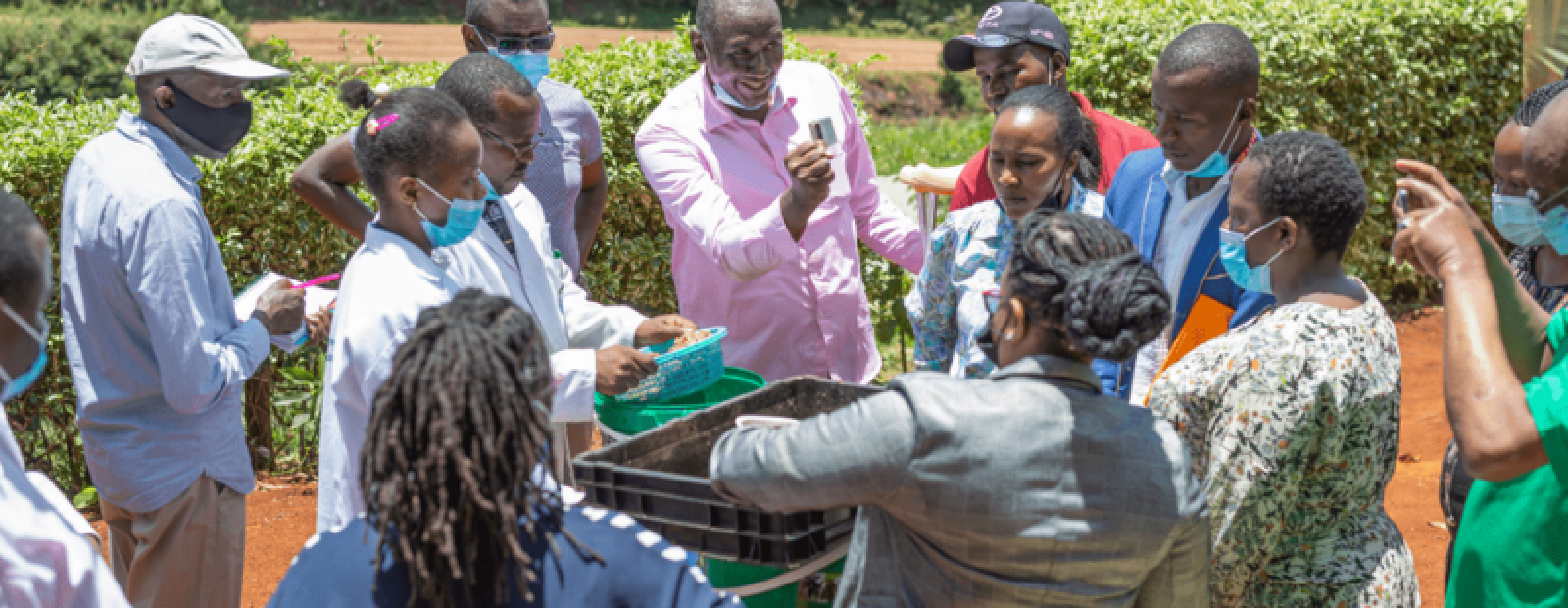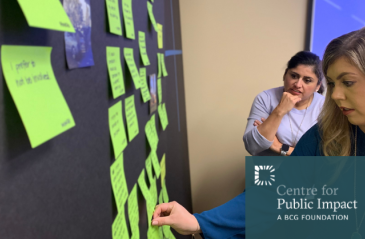
Mayors Challenge: Lighting up Latin America


Around the world, the pandemic exposed weaknesses in public systems, and city governments stepped up to tackle these challenges. This was the theme of the 2021 @BloombergDotOrg Global Mayors Challenge, launched in partnership w/ @CPI_foundation
Share articleAs a learning partner for govts, @CPI_foundation compiled insights from work w/ 50 cities participating in @BloombergDotOrg 2021 Mayors Challenge that others can learn from when tackling complex challenges in their communities
Share article"Innovation is contagious, and the @BloombergDotOrg Mayors Challenge launched in partnership w/ @CPI_foundation proved a real appetite for collaboration among government changemakers worldwide." @OsborneBrown4 shares insights
Share articleWe put our vision for government into practice through learning partner projects that align with our values and help reimagine government so that it works for everyone.
“This pandemic has been a wake-up call for us to be innovative to facilitate resident recovery and increase resilience against future shocks.” - Solange Muhirwa, chief of urban planning for Kigali
If necessity is the mother of innovation, the past two years have created countless opportunities for growth. In the early days of the COVID-19 pandemic, many cities around the world were overwhelmed by the urgent needs in sectors like healthcare, education, and social services. Beyond the initial crisis, however, additional challenges came to light - issues both longstanding and newly exacerbated by the ongoing pandemic.
All around the world, the pandemic exposed weaknesses in public systems in ways not previously anticipated, and city governments stepped up to tackle these challenges. This was the theme of the 2021 Bloomberg Philanthropies Global Mayors Challenge, a program launched in partnership with CPI, which recently announced its 15 winners.
At CPI, we believe that cities are the “laboratories of democracy” and, therefore, are in the best position to efficiently test and scale solutions that could one day make life better for people across the globe. As a learning partner for governments, we compiled some insights from our work with the 50 cities participating in the 2021 Mayors Challenge that we believe other cities, states, and countries can learn from when tackling complex challenges in their communities.
At CPI, we believe that cities are the “laboratories of democracy” and, therefore, are in the best position to efficiently test and scale solutions that could one day make life better for people across the globe.
Over a year ago, Bloomberg Philanthropies announced that the 2021 Global Mayors Challenge would focus on cities with innovative solutions to problems created or exacerbated by the COVID-19 pandemic. In the face of a public-health crisis, social unrest, massive budget shortfalls, and mounting climate disasters, the Mayors Challenge encouraged cities to tackle issues head-on and, ultimately, create stronger systems than the ones they had before. Over 630 cities stepped up to the plate and applied to the Challenge, and nearly half of the submissions were generated through participatory processes with residents. From hundreds of powerful ideas, 50 cities were chosen as the 2021 Champion Cities.
The Champion Cities quickly realized the complexity of the problems they were trying to solve. They each had to dig deeper into the issues, the residents affected, and the questions yet unanswered. Valena McEwan, communications lead for the Mayor Development Unit in Freetown, explains, “It is a lot easier to solve a problem with residents than solve a problem for them.” As each city soon learned, even the simplest problems they faced usually had deepening levels of intricacies. With every resident interviewed and every street walked, the governments found a deeper level to the problem.
As the city teams began to tackle these problems directly, they leaned heavily on the residents themselves. The design teams used the human-centered design approach to fully understand the needs of the residents and design the solutions around them. “The great advantage of the design thinking model is that you start from the perspective of the users,” explained Jan Mellebeek, head of local policy action for the city of Leuven. “Often you automatically start thinking from the idea of 'what does the government want', but you have to think about 'what does a resident want.’”
Even the simplest problems they faced usually had deepening levels of intricacies. With every resident interviewed and every street walked, the governments found a deeper level to the problem.
Ultimately, over 5,000 city residents were able to share their ideas and feedback for how the cities could better address their needs. These residents became the core of networks that served as change champions in their communities. Gitonga K. Angelo, director of environment and climate change for Meru City, articulates, “Involvement of residents on any project that has an implication for them is a critical success factor in that project.”
Beyond gaining resident perspective, the participants also often served as early adopters for the solutions. Professor Kasonde Bowa, Executive Dean of Medicine at the University of Lusaka, explains, “We have provided solutions in the past but they may stay in the research or the publications, they never really reach the community. The human design perspective allows you to see what the community actually thinks about this, and how we can make a solution that is sustainable.”
In addition to working with residents, the Mayors Challenge cities brought in a range of diverse partners as they worked to unpack their selected problem and design solutions. For some cities, partners were brought in early to support connections with residents. In others, partners provided expert insights for solution development. And in others still, partners were key for solution implementation. Whether they provided expertise for a portion of the Challenge or they engaged throughout (and beyond!), partners were imperative for city success.
In the city of Birmingham, Alabama, a non-profit partnership served to connect the Mayors Challenge team with individuals that were key to the city’s solution: students. Birmingham’s work centered on the troubling issue that nearly 70 percent of residents have limited access to food, especially fresh produce. “It’s so taxing on some of our neighbors just to get fresh food,” explained Birmingham resident Darlena King, whose journey to purchase fresh food includes a mile-long walk to a bus stop and a bus that sometimes never comes. To address this challenge, the mayor's office partnered with a local non-profit, Jones Valley Teaching Farm, to create a program in which students could develop a series of community farms around the city. These agrarian hamlets provided local, sustainable, and available produce to neighborhoods in need. In addition to tackling the issue of food access, the solution simultaneously provides a group of young residents with valuable work and professional experience.
Over in Paterson, New Jersey, the city learned that 80,000+ people nationwide died of a drug overdose in 2020. Alarmed by the impact in Paterson, the city team developed a program for residents to call a dedicated hotline that provides specialized care through medically assisted treatments. Through partnership and collaboration with social workers, healthcare providers, and other medical professionals, the Mayors Challenge team in Paterson developed a treatment plan that could be implemented within 90 minutes. After vigorously testing this program with healthcare and institutional partners, the city plans to roll this program out as a standard of care for victims of opioid addiction.
In light of much of the world moving online during the COVID-19 pandemic, it comes as no surprise that tech and digital played a substantial role in this year’s Challenge. Of the 50 cities that leaned most heavily on technology for their solutions, we were struck by their focus on human elements. Rather than producing a ‘shiny’ tech solution, cities primarily used technology as a means to centralize and streamline existing digital resources and processes or to facilitate human connections.
The team in Istanbul, Turkey, saw that many residents were unable to meet basic needs such as utility payments, rent, or other necessities during the pandemic. They wanted to create a process by which residents could come alongside one another and support each other in times of need. The result was the Askida Fatura campaign, an open-sourced, anonymous, and heavily-used application that allowed residents to donate money to provide for other residents’ needs. In the first few months of operation, the platform raised over $6 million and benefitted an estimated 1 million residents. Aydan Arat, a retired teacher from Istanbul who anonymously donated through the campaign, explains, “The Askida Fatura campaign has revealed the spirit of cooperation and solidarity in people. It has brought together those who try hard to keep food on the table, who are not working, or who are unemployed, and those who are in a good financial condition—and they have not even seen each other.”
Meanwhile, the team in Manila, Philippines, developed an application that centralized online resources for residents in various economic conditions. They realized that many communities of low-income residents were the hardest hit by the early stages of the pandemic, so they created a system that could digitally connect these people to the necessary resources like healthcare, social security, or job sites. The city also worked to build relationships in the private sector by implementing a streamlined source for city functions such as zoning and data-driven decision-making. Ultimately, these functions came together in the city’s “GO Manila” app, which has been the cornerstone of the Mayor’s policy work since the start of the pandemic.
One of the Global Mayors Challenge goals is to create ideas that can spread to other cities around the world. Innovation is contagious, and the Mayors Challenge proved a real appetite for collaboration among government changemakers worldwide. For example, Istanbul has already received requests from more than 20 cities across the globe who are interested in replicating their online platform to support communities in their locale. The global interest in this Mayors Challenge solution illustrates the ripple effect these ideas can have. One city can take a chance on an idea that might one day impact the lives of people all around the world.
Innovation is contagious, and the Mayors Challenge proved a real appetite for collaboration among government changemakers worldwide.
Over the past year, city leaders participating in the Global Mayors Challenge came up with ideas that were innovative, sustainable, and scalable to other cities and communities across the globe. From urban farms to crowdsourced community support funds, the ideas of this year’s Challenge addressed the core issues faced by residents in these cities. We looked at each of the projects from a global perspective and were blown away by the breadth of topics covered in the submissions. This week, Bloomberg Philanthropies announced the 15 winners of the 2021 Global Mayors Challenge. These 15 winners are being recognized for designing the boldest and most ambitious urban innovations to emerge from the global COVID-19 pandemic.
In times like today, it is easy to hear of the troubles we face. It is easy to hear the stories of failed governments, abandoned citizens, and hopeless public systems. It is easy to hear these things, but they are not the full picture. The full picture includes changemakers dedicated to making governments better, and to better serving residents as a result. City halls around the world have rallied around their residents and decided to take a stand for their well-being. Mayors have staked their time, reputations, and even their careers on the progress made during the Mayors Challenge. This herculean effort is not one to be taken lightly. But despite obstacles and difficulties, the Mayors Challenge taught us that city halls are filled with people willing and excited to step up. We were proud to support over 300 government changemakers during the 2021 Global Mayors Challenge, and we can’t wait to see what they do next.
Learn more about the 15 cities with the boldest and most ambitious urban innovations to emerge from the Global COVID-19 pandemic.





